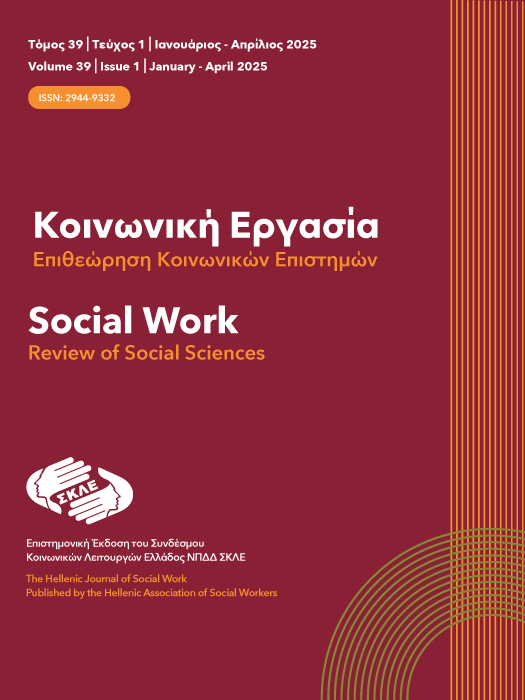Ο Ρόλος των Ζώων στα Καταθλιπτικά Συμπτώματα και τη Μοναξιά στα Άτομα Μεγαλύτερης Ηλικίας: Μία Μικτής Μεθόδου Συστηματική Ανασκόπηση

Περίληψη
Η δημογραφική γήρανση, οι προκλήσεις της ενεργού γήρανσης, και τα αυξανόμενα ποσοστά καταθλιπτικής συμπτωματολογίας και μοναξιάς στα άτομα μεγαλύτερης ηλικίας, πιέζουν τους ειδικούς να ανακαλύψουν καινοτόμες μορφές υποστήριξης για τα άτομα μεγαλύτερης ηλικίας. Μία πρόταση με ελπιδοφόρα αποτελέσματα, η οποία και απασχολεί τη διεθνή ερευνητική κοινότητα, είναι ο ρόλος των ζώων. Ο κύριος σκοπός της παρούσας ανασκόπησης είναι να εξετάσει των ρόλο των ζώων στα καταθλιπτικά συμπτώματα και τη μοναξιά ατόμων μεγαλύτερης ηλικίας, αξιοποιώντας μία μικτή συστηματική μεθοδολογίας. Το άρθρο αυτό ακολουθεί τις οδηγίες και τη λίστα ελέγχου PRISMA (2020) για συστηματικές ανασκοπήσεις. Αναζήτηση πραγματοποιήθηκε για συναφή ερευνητικά άρθρα στην αγγλική γλώσσα από το 2019 έως τις 03/29/2024 σε διεθνείς βάσεις δεδομένων (PubMed, Scopus, ScienceDirect)οι οποίες παρείχαν πληροφορίες για το εξεταζόμενο θέμα. Η επιλογή και διαλογή των άρθρων έγινε με την αξιοποίηση των οδηγιών του διαγράμματος ροής PRISMA (2020) για συστηματικές ανασκοπήσεις. Για την αξιολόγηση της ποιότητας των συμπεριλαμβανομένων άρθρων εφαρμόστηκε το MixedMethodsAppraisalTool (MMAT).Ακολουθώντας αυτή τη διαδικασία, 856 άρθρα προέκυψαν από όλες τις βάσεις, από τα οποία, μετά την αφαίρεση διπλότυπων και τον έλεγχο συνάφειας σε τίτλο και περίληψη, 13 τελικά επιλέχθηκαν. Τα 8 ακολουθούσαν ποσοτικό σχεδιασμό και τα 5 ποιοτικό. Αν και προέκυψαν μικτά αποτελέσματα από την ανάλυση, ειδικά όσον αφορά την κατοχή κατοικίδιων και τα συμπτώματα κατάθλιψης που απαιτούν περαιτέρω έρευνα, στις περισσότερες περιπτώσεις, τα ζώα διαδραματίζουν καθοριστικό ρόλο στην ανακούφιση των συμπτωμάτων κατάθλιψης και στη μείωση της μοναξιάς στα άτομα μεγαλύτερης ηλικίας. Η έρευνα αυτή υποδηλώνει περισσότερες ευκαιρίες για νέες πρακτικές εφαρμογέςακόμα και εκτός του περιβάλλοντος της ιδρυματικής φροντίδας
Λεπτομέρειες άρθρου
- Πώς να δημιουργήσετε Αναφορές
-
Σαλάχας Α., & Μέντης Μ. (2025). Ο Ρόλος των Ζώων στα Καταθλιπτικά Συμπτώματα και τη Μοναξιά στα Άτομα Μεγαλύτερης Ηλικίας: Μία Μικτής Μεθόδου Συστηματική Ανασκόπηση. Κοινωνική Εργασία. Επιθεώρηση Κοινωνικών Επιστημών, 39(1), 40–63. https://doi.org/10.12681/socialwork-rss.40605
- Τεύχος
- Τόμ. 39 Αρ. 1 (2025): 1/2025
- Ενότητα
- Άρθρο

Αυτή η εργασία είναι αδειοδοτημένη υπό το CC Αναφορά Δημιουργού – Μη Εμπορική Χρήση – Παρόμοια Διανομή 4.0.


